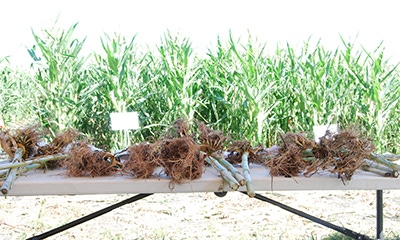
Corn rootworm is a persistent and economically important pest in Iowa, with yield loss caused primarily by larval feeding on corn roots. Genetically modified corn with Bt traits kills western and northern rootworm larvae, and Bt-rootworm corn has been available since 2003. However, some Iowa farmers have observed severe root injury to Bt corn hybrids in continuous cornfields, and there has been documented resistance of western corn rootworm in Iowa to Cry3Bb1 corn and mCry3A corn since 2009 and 2011, respectively.

ROOTWORM RISK: All cornfields in Iowa are at risk for infestation by rootworm and should be scouted or roots spot-checked each year. Because it’s difficult to predict larval injury based on adult beetle abundance the previous season, farmers should manage larval rootworm if growing corn following corn.
Iowa State University Extension entomologist Erin Hodgson and ISU research entomologist Aaron Gassmann provide the following update on recommendations for controlling corn rootworm in Iowa.
New research updates on western corn rootworm resistance
Building on previous studies at Iowa State University, the Gassmann Lab was able to show the magnitude of field-evolved resistance to Cry3Bb1 for western corn rootworm as it increased between 2009 and 2011. This is a common trend for pests that continue to be exposed to the same management tactic once resistance has begun to develop.
* Recent work with western corn rootworm populations in Iowa has found cross-resistance among three of the four Bt traits CryBb1, mCry3A, and eCry3.1Ab. This means that rootworm populations that are resistant to Cry3Bb1 will likely be resistant to mCry3A and eCry3.1Ab.
* Most recently, there is evidence of field-evolved resistance of western corn rootworm to Cry34/35Ab1 in Iowa (Photo 1). In 2013, four fields were identified with greater-than-expected root injury to corn hybrids containing the Cry34/35Ab1 trait. Subsequent lab bioassays found that this injury was associated with resistance to Cry34/35Ab1. However, this resistance was incomplete (survival on Bt corn was less than non-Bt corn) and thus far appears to be limited in its geographic distribution within Iowa.
* In some areas, extended diapause by northern corn rootworms caused root injury to first-year corn. To date, there have not been any cases of Bt resistance by northern corn rootworm to any traits. Normal and extended diapause variants of northern corn rootworm do not lay eggs in soybeans.

Photo 1. Severe root injury to Cry34/35Ab1 cornfields.
Economic thresholds you can use to make decisions
All cornfields in Iowa are at risk for infestation by corn rootworm and should be evaluated annually. Because it is difficult to predict larval injury based on adult abundance the previous season, farmers in Iowa should manage larval rootworm if they are growing corn following corn. “We highly encourage farmers to assess the efficacy of their larval corn root management by evaluating root injury on the zero to three node-injury scale,” says Hodgson. The economic injury level for larval rootworm feeding typically ranges between 0.25 and 0.5 nodes, and will depend on environmental conditions (e.g., drought), commodity prices and management costs. In general, every node of roots lost to larval rootworm feeding results in a 15% to 17% reduction in yield, she says. Farmers should adjust their management approaches to keep larval feeding injury below the economic injury level.
The U.S. EPA uses the classification of greater-than-expected injury when root injury exceeds one node to single-trait Bt corn and 0.5 nodes to pyramided Bt corn. When greater-than-expected injury occurs it is reasonable to suspect that resistance may be present but only follow-up laboratory or field experiments can confirm the presence of resistance, say Hodgson and Gassmann.
Management recommendations to control corn rootworm
The last two summers, Iowa had below-average corn rootworm populations due to extremely wet spring conditions. You can expect rebounding numbers of western and northern corn rootworm if this spring has more moderate temperature and moisture conditions during May and June, the ISU specialists say.
Although resistance to all four Bt rootworm traits has been confirmed for western corn rootworm in Iowa, resistance to Cry34/35Ab1 appears to be incomplete and limited in geographic scope. However, cases of Bt resistance demonstrate the potential vulnerability of Bt corn for rootworm management and highlights the importance of using a diversified approach when managing rootworm. Farmers should develop a long-term integrated pest management approach for corn rootworm, Hodgson and Gassmann advise. Here are their recommendations.
Use these tactics when developing a rootworm management plan:
1) Crop rotation remains an effective tactic in Iowa cornfields. Although rotation-resistant northern corn rootworm is present in Iowa, rotation resistance by western corn rootworm is extremely rare in Iowa. Rotating to a non-host crop will break the lifecycle of western corn rootworm and rotation-susceptible northern corn rootworm. Typically, crop rotation will greatly reduce rootworm abundance in a field during subsequent growing seasons. Consider rotating a field out of corn production at least every five years.
2) Use Bt corn hybrids that contain the Cry34/35Ab1 trait pyramided with a second rootworm Bt trait. However, understand that if western corn rootworm has developed resistance to one of the traits in a pyramid, the utility of a pyramid is reduced.
3) Use a non-CRW Bt hybrid with soil-applied insecticides. Layering traits with soil-applied insecticides is not recommended because it is typically not necessary if Bt corn pyramided with Cry34/35Ab1 is planted. Also, layering traits with insecticide may accelerate resistance to both strategies.
4) Adult corn rootworm beetle management requires intensive sampling and a well-timed application of foliar insecticides. In general, this is not a cost-effective management option for corn rootworm, say the ISU Extension entomologists.
About the Author(s)
You May Also Like




